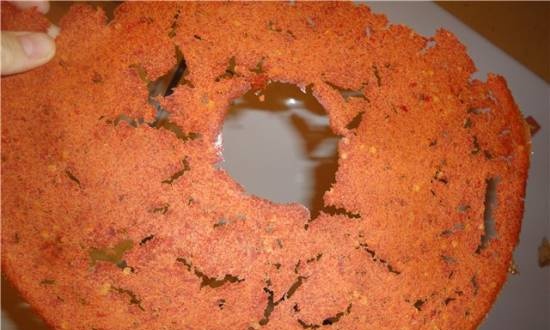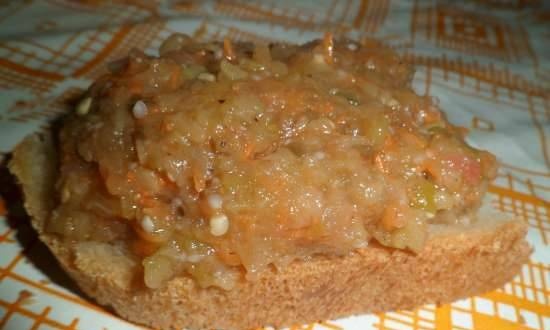primitive housewife style.
Mixed flour with water. She went to swell as long as she needed, in different ways. From half an hour to as much as 3 hours and it happens
At this time, a miracle happens there - a very hard lump of thick rubber threads - gluten - is formed from proteins when combined with water.
If you leave it like that and then just bake, there will be a very hard sole, rubbery for a bite.
This is how we make the dough for dumplings. Knead, let it swell, that is, wait until gluten forms, then cut and cook. And there they get a dense unleavened dough.
But if this dumpling dough is kneaded and saturated with gas, that is, well, like in chewing gum, these rubber threads are made thin, and there is a lot of air between them, then we will get bread: an elegant 3D frame made of thin threads of gluten with air, and the meat on them will be soft wet swollen starch (well, you know - a delicate jelly substance - a delicate crumb on fine or coarse gluten)
The consistency and crumb of the bread will depend on how much you wet your flour (or rather, how much it is capable of swelling - the strongest of all) and then you knead and stretch the gluten threads. You stretch them mechanically with handles and chemically with yeast breathing. Yeast gives off a gas that stretches and inflates the gluten framework.
That is, here is the process of forming bread.
The flour swelled, gluten was formed, then it was caked, thinned, made tender and blown up with gas, baked.
The stronger the flour is able to get wet and give gluten, the higher the bread can be stretched and lifted. The more fibrous you can get bread from the finest, finest gluten.
Weak flour also has a thin graceful gluten after kneading and swelling, but not as elastic. This is a softer rubber band initially. Less stretchable and easy to tear. This is reflected on the bite as very inelastic.
Unmixed gluten-free bread is coarse rubbery threads. But the stronger the gum, the more rubbery it bites.
Well, from here you understand why only kneaded bread can have a thin crust. The crust is the bread stretching first of all. The tighter it is, the thinner and more graceful it is.
Let's go further.
So, we wetted the flour and put the yeast in there.
Yeast begins to eat and breathe. Breathing - develops gluten, tightens. When eaten, the yeast changes the composition of the dough, adds gas and all sorts of products of its vital activity, which are important for a completely separate - parallel process in bread: the accumulation of its taste.
Parallel the physical structuring itself is an accumulation of taste. This is a completely independent process.
The flour contains bacteria that begin to live and their waste products add new substances to bread, all kinds of useful and unhealthy acids. It is the work of bacteria that we owe to the taste of our bread.
The bacteria begin to live individually. Some of them die at once, some survive. The type of survivors will depend on the temperature of the surrounding dough, on sterility, on the amount of gas for breathing, on the nutrients in the dough, which they receive, including from the waste products of the yeast.
The accumulation of taste is the longest process because bacteria are very slow substances. You need at least 4 hours to minimum giving flavor to bread. That is why it is impossible to get delicious yeast bread in 2 hours.
The longer the tasty bacteria work, the tastier the bread.
It would seem, well, let the bread wander for at least a week, BUT
always another separate parallel process is launched in the test - destructive.
These are all sorts of active substances in flour + putrefactive bacteria trying to destroy the resulting gluten and saturate the dough with the waste products of putrefactive bacteria. This last process is tried in every possible way to extinguish. It cannot be completely stopped, which is why, over time, any dough dies.
Therefore, I return to our rams.
Can you leave the dough warm with yeast for a long time?
and reason for yourself:
- as soon as you put the yeast in, it began to breathe and stretch - develop gluten and accumulate its waste products in the dough. It feeds everything !!!! bacteria that secrete acids and change the taste of bread, but at the same time the active substances in the flour are bad !! bacteria spoil the bread.
- secondly, the yeast needs to breathe and eat, if there are a lot of them or they sit in one place for too long, they will devour everything around them and suffocate. Therefore, the bread is crushed so that the yeast gets new nutrition and breath.
thirdly, the specificity of taste will be formed depending on the temperature of the dough. The type of bacteria that will survive. Bread is sour in the cold than in the warmth, because acidic bacteria survive in the cold.
- in the fourth, the destructive process does not sleep. Putrefactive bacteria and active substances will try to take everything into their own hands and kill the dough.
the most deadly is the last point. Heat and lack of oxygen, the initial dirt in the flour, the presence in it of its own destructive active substances, the very ones that are so useful in the cereal plant, dead yeast - all this contributes to the strengthening of this process.
If you just knead the dough and leave it in a warm room in the summer, it will easily rot, because the destructive process wins.
Therefore, they are struggling with this phenomenon in every possible way.
Therefore, in order to accumulate taste, humanity contrives in every possible way. It tries to lengthen fermentation and muffle destruction.
To do this, it puts the dough into the cold for a long time, it first makes the dough in a special way so that the taste accumulates there, and then makes the main dough. That is, all these dances are to accumulate taste without destroying the dough, to make bad bacteria and substances sit and not rock the boat for as long as possible.
Therefore, what does bread with yeast mean without kneading in the heat)))
And the fact that in the warmth and in the absence of oxygen - that is, kneading, harmful bacteria and active chemicals love to develop.
But their intensity will depend on the primary conditions. The more sterile and empty the flour, the longer it will stand.
And if you try to leave the central lock in this way, the result may be disastrous.
Then, depending on how much yeast you put in and how quickly they gobble up everything around them and begin to die. The process is accelerated in warmth.
Or they will quickly accumulate excessive gas and tear the gluten in your flour into rags before you have time to knead and release the excess gas.
Therefore, if the recipe is home-grown and does not take into account the characteristics of your flour and the strength of your yeast, then the result is unpredictable.
It may or may not work.
Then sanitary safety is also in question. How much there you have accumulated harmful acids in bread, FIG knows.
Technologists work out recipes and fermentation time from all scientific aspects, including the usefulness.
When I propose to make a pre-batch on dumplings with a programmed stand for half an hour or an hour in the heat, this is one thing. This is too short a time for irreversible harmful processes to occur in the test, and then the professional HP program takes matters into its own hands.
And to advise to leave for a day - I'm not a technologist. You do this at your own peril and risk.I do not presume to judge the new recipe, there is not enough competence.
If I feel the urge to make a long bread, I will look at the recipes on the classic dough, or choose fermentation in the cold. In general, I will look in the direction of professional techniques, it seems safer to me.
I am not a technologist, I cannot check out every new recipe from all sides.
Why do we pre-mix dumplings?
pre-mixing on dumplings makes sense only on domestic flour, which has the peculiarity of swelling for a long time, that is, the proteins absorb water, but gluten is still not formed. And then the KP program kneads the clay, and does not knead the gluten.
Special bourgeois flour for HP forms gluten instantly and pre-mixing on dumplings is absolutely pointless.
But on domestic flour such as makfa, in these half an hour gluten is formed from proteins and HP will knead it, as planned by the engineers.
As I wrote above, in especially neglected cases, our flour is generally good for about an hour to stand up to swell.
Kneading involves stretching a tight elastic band of gluten. And if it's not there at all, there is no point in interfering ahead of time
Che .. I'll add more. That's when they write "suitable for HP" on a packet of flour - it means that any pre-mixes are meaningless. I mean, I'm talking about what you like to call "autolysis".
There, they mixed it with water - bang right away in a matter of minutes - and from proteins the maximum amount of gluten and you can immediately start kneading.
And we need to give time for swelling to our usual flour, which is slow. Which takes time to form a gluten-gum, which must be kneaded only when it has already formed.
And when we put ordinary flour in HP, the machine begins to mix the clay from the water with proteins. She finished kneading - and there is still only a little gluten. It continues to form, but no one kneads it, only the yeast is a little bit, and their strength is not enough, and the output turns out to be rough bread and dense thick crusts.
... Under-mixed bread made from weak flour is still tender, but from strong flour it is rougher.
How to solve the problem with the amount of yeast? and with kneading and autolysis?
yes in practice.
We make test baking and see the result.
Too loose, stinks of yeast, strange taste - we reduce the yeast. Too coarse crumb - intensify kneading. Empty taste, we improve the flour for tasty substances with baking or more tasty flour, whey and choose a longer fermentation mode.
Practice and analysis of the result. We are working on one recipe and sorting it out. 




